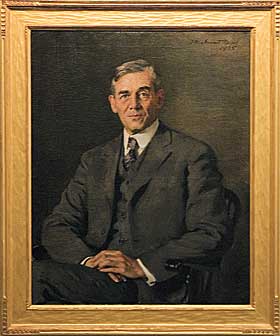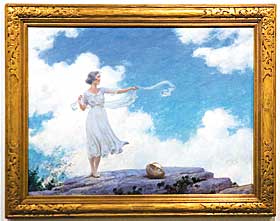  |
| HOME | THIS ISSUE | CALENDAR | GRANTS | BACK ISSUES | < BACK | NEXT > |
Exhibit showcases Benton Museum’s founding collectionsby Sherry Fisher - October 23, 2006 |
|||||
| Charles Lewis Beach would doubtless have been proud to visit the William Benton Museum of Art today. Beach, president of the Connecticut Agricultural College from 1908 to 1928, was an avid art collector. The personal art collection he started in 1926, along with works collected by Walter Landauer, a professor of animal genetics from 1924 to 1965, became the foundation of the Benton. The President and the Professor, an exhibit in the Gilman Gallery that opened last week and will runthrough Dec. 20, includes artwork donated by Beach and Landauer. The works are part of the museum's permanent collection. Beach and Landauer had something in common, says Thomas Bruhn, curator of the exhibit: "They saw the works that they collected as an educational tool for the students at the College. They had a very humanistic outlook about art and how it could broadly enhance the humanistic role of the College, even though at the time it was clearly a School of Agriculture." During the period that Beach was collecting, he referred to his artwork as the "College collection." Bruhn says Beach's interest in art began during his wife's illness. When Louise Crombie Beach was seriously ill in 1923, a few of her lady friends pooled their resources and bought a little landscape painting of the Rockport, Mass., harbor to hang in her bedroom. "The painting takes pride of place in the Beach collection," Bruhn notes, "because the work apparently opened Mr. Beach's eyes to the pleasure art could give." Louise Crombie Beach died in early 1924. In February 1926, President Beach decided to create an art collection to honor his wife, and to educate students. "Whether this was his or someone else's idea, the thought was consistent with his ambitions for the College," Bruhn says. "He believed that education was more than vocational, despite a vocal agricultural lobby which thought otherwise." Beach's collection was built around landscapes, coastal scenes, and domestic interiors. He also included several nudes, which raised some eyebrows. "When asked about the nudes," says Bruhn, "Beach noted in his journal that they were there 'to satisfy the curiosity of male youth and to illuminate his intellectual faculties regarding the female form and figure - familiarity with the nude in sculpture and painting should contribute to sanity and morality in life.'" Beach continued to buy paintings, and established the Louise Crombie Beach Foundation, which was authorized to use funds designated in his will for future purchases. He gave the collection to the College, and pieces were hung in campus buildings. Some 30 years later, the collection found a permanent home in the building known as the Beanery. In 1967, the building became the University Museum of Art, and then the William Benton Museum of Art in the early 1970s. Landauer came to the College in 1924 from the Univeristy of Heidelberg in Germany. He began collecting works by 20th-century German artist Käthe Kollwitz in the 1920s. Kollwitz and Landauer grew up in Germany in an atmosphere of social activism, Bruhn says. A conscientious objector, Landauer served during World War I in the International Red Cross. After the war, Germany faced a time of political, economic, and social upheaval. Landauer wrote for German, Swiss, and Austrian left-wing and socialist journals. His writings indicated a wariness of capitalism, concerns about both individual and academic rights, and anti-war sentiments. In 1922, after earning his doctorate, he spent two years as an assistant in the zoological laboratory at Heidelberg. In 1924, he decided to leave Germany and move to the United States. It's not surprising that Landauer would be attracted to Kollwitz, says Bruhn. Her strong social conscience was reflected in her art. She created many posters and illustrations for different causes, often depicting images of uprisings, revolts, death, and war. Bruhn says Landauer's house was filled with Kollwitz's works, and he would talk about how they reflected conditions in Germany. Kollwitz wrote him a letter in 1927, expressing gratitude for his interest in her art: "The idea that there is someone in the United States who values my work and communicates its value to students, is very important," she said. When he retired in 1964, Landauer bequeathed his collection of her work - comprising 107 etchings, lithographs, woodcuts, and drawings - to the University.
|
| ADVANCE HOME UCONN HOME |



